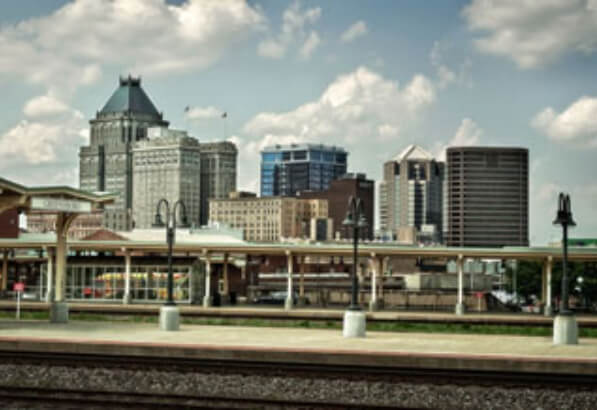
Downtown

Greensboro’s downtown is a thriving economic center that has been vibrant since the late 19th century. New construction is almost a constant. Even during the Great Depression of the 1930s, construction was noticeable. During the 1950s, business slowed and people flocked to the suburbs for space and expansion. Emptiness gradually increased over the next 30 years. In the 1990s, the downtown area reignited and thrived to become the destination it is today. Downtown Greensboro is a prosperous and vibrant urban center today, memorable and meaningful for those who choose to live, work, and play here.
Landmarks

- In 1918, the upscale O.Henry Hotel opened, taking up more than a block. Another luxury hotel, the King Cotton, came in 1927.
- In 1920, the nine-story Southeastern Building opened as one of the tallest buildings in the city at the time. Three years later, the 17-story Jefferson Standard Building (now Lincoln Financial), broke its record.
- The 1920s also brought the Carolina Theatre, the lofty Guilford Building, the block-long Southern Railway Train Station, the collegiate-like Cone Export and Commission Building, the Masonic Temple, and others, all of which still stand today.
- In 1990, three high-rises, the 19-story Renaissance Plaza, the 21-story structure now called Wells Fargo Tower, and the 21-story Jefferson-Pilot Building connected to the old Jefferson Building, created a new Greensboro skyline.
- In the mid-1980s, what are now the Lofts Apartments opened as a row of commercial buildings along the 300 block of South Elm Street, with the complex extending to North Davie Street.
Business
Belk, Meyer’s, Ellis-Stone, Montgomery Ward, and Sears department stores kept their reputations as favorite shopping places for residents from all over the central Piedmont and southern Virginia.
Nearly every block of downtown included a restaurant and gas station.
Historic Happenings

- On February 1, 1960, four N.C. A&T State University students staged a sit-in to integrate Woolworths' whites-only lunch counter. In 2010, the International Civil Rights Center & Museum opened in the former Woolworth store on the 50th anniversary of that sit-in.
- The old Southern Railway Station opened in 1927 as North Carolina’s biggest station. A renovation in the late 1990s and early 2000s turned the complex into the J. Douglas Galyon Depot, a transportation center for Amtrak trains, local and regional buses, and long-distance Greyhound buses.
- Action Greensboro, funded by local foundations, built what is now called NewBridge Bank Park downtown for the minor league baseball team, the Greensboro Grasshoppers. Since opening in the early 2000s, the stadium has set attendance records for minor league baseball.
- Action Greensboro also created another destination: Center City Park, a block near the center of downtown, that offers grassy spaces with fountains, benches, trees, a band shell, and other amenities.
- In 2006, Elon University opened its new law school in the former public library on North Greene Street. It has attracted nearly 300 students, faculty, and staff to downtown.
Recent Events

- The original 16-story Wachovia Building, which opened in the mid-1960s, closed in 1990 to remove asbestos. Wachovia found a new location downtown. The old Wachovia building stayed empty until 2010 when it was converted into the luxury Center Pointe condominiums.
- In the 1990s, Downtown Greensboro, Inc. opened for business. Its maintenance crews keep the sidewalks and gutters clean and watered flower baskets hanging from utility poles next to street trees.
- Apartments and condos multiplied on the tops of commercial buildings along South Elm Street in the late 1990s.
- In the early 2000s, new condominium complexes were built, including Governors Court, Arbor House, Smothers Lofts, and Center Pointe. Afterward, the enormous City View Apartment complex opened across from South Side, providing hundreds with downtown residential living.
- Restaurants currently line South Elm, offering culinary delights to both diners in a rush and those opting for more leisurely dining. Nearly all downtown quadrants now boast new restaurants and taverns.

